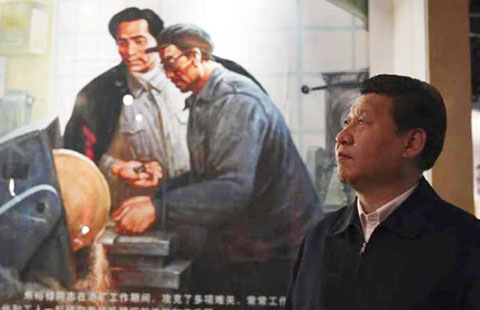Life during wartime in Shanghai's safe haven
Updated: 2014-03-19 10:39
By Zhao Xu (China Daily)
|
||||||||
Forging a foothold
"Overnight, they appeared among us, seeming to have come from nowhere," said Quan Furong, who lived with his family on Huoshan Road, a tiny section of Hongkou that was soon to become a foothold for the newcomers. "They slept on double- or triple-decker beds, learned to start a coal fire and to use the Chinese equivalent of a chamber pot - a large wooden device that had to be hauled outside to be emptied every morning."
Quan's father rented six rooms to asylum seekers and it didn't take long for the Chinese landlord to be impressed by his new tenants' business acumen. "I remember seeing some of my Jewish neighbors knocking on the door of our tailor shop trying to sell fabrics to my father. We were so impressed by the fact that they were able to find Shanghai's wholesale cloth market within a month of arriving," he said.
Gradually, the newcomers built a palpable Jewish center, transforming the area into "Little Vienna", complete with stores and beautiful roof gardens.
Some of those who endured those far-off days are determined not to let the memories fade. In June 2011, Vera Sasson, then 73, traversed the city's streets, holding a black-and-white photograph of a Chinese man she called "Uncle Chu".
In 1939, Sasson arrived in Shanghai with her family from Vienna. She was 8 months old. For the next 10 years, she grew up alongside Chinese kids and became a fan of "Uncle Chu", a 40-something neighbor. "He arranged for a personal rickshaw to take me to school and back home. After school the rickshaw dropped me off in front of 'Uncle Chu's' home, and he always insisted that I stay and have a meal with his family before going home," wrote Sasson in an e-mail exchange with China Daily.
Her search eventually led to the Shanghai Jewish Refugees Museum, previously the Ohel Moshe Synagogue in Hongkou district.
Chen Jian, the museum director, has overseen the building's transition from the center of the Jewish refugees' life to a monument. "Of all the holocaust museums, only ours tells a story of survival," he said.
One of those survivors is Betty Grebenschikoff, who arrived in Shanghai with her family in 1939, aged 10, little realizing that she would spent a decade in the city, more than 12,000 kilometers from home.
Footage shot by the museum during Grebenschikoff's last visit in November, the fifth since she returned to Europe, shows the 84-year-old in the cramped room in which her family once lived - an 8-square-meter second-story space with wide windowsills.
"My mother used to put rice out on the windowsills," she told a small crowd of residents and local media. "You let it sit there for four or five minutes and the bugs would come crawling out. My sister and I would count who had the most."
 |
 |
| Weihsien: Life and death in the shadow of the Empire of the Sun | In memory of unnamed war heroes |

 Skyscrapers in E China resemble LV check pattern
Skyscrapers in E China resemble LV check pattern
 President Xi honors memory of devoted county Party chief
President Xi honors memory of devoted county Party chief
 More than just food
More than just food
 Miss world visits cancer children in Colombia
Miss world visits cancer children in Colombia
 Chinese paintings exhibited at Sotheby's
Chinese paintings exhibited at Sotheby's
 Jewish holiday of Purim celebrated in US
Jewish holiday of Purim celebrated in US
 Nurturing the art scholars of tomorrow
Nurturing the art scholars of tomorrow-
 Skyscrapers in E China resemble LV check pattern
Skyscrapers in E China resemble LV check pattern
Most Viewed
Editor's Picks

|

|

|

|

|

|
Today's Top News
Tourists offered compensation for bad air days
US first lady's China visit to boost relations
New US envoy hits ground running
Tourists offered compensation for bad air days
Thai radar may have detected missing Malaysian jet
Chinese authorities upgrade food waste fight
Textiles creats for jobs in Xinjiang
First lady's China trip aimed at better ties
US Weekly

|

|







